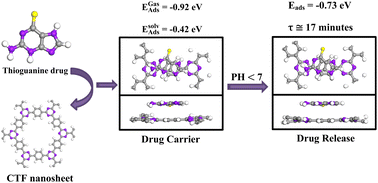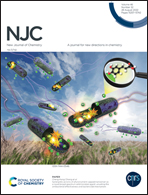Two-dimensionalcovalent triazine frameworks as superior nanocarriers for the delivery of thioguanine anti-cancer drugs: a periodic DFT study†
Abstract
This work aims to introduce a superior nanocarrier for thioguanine (TG) anti-cancer drug delivery, drug release, and cancer therapy through computational chemistry. First, the properties of TG drug adsorption on covalent triazine-based frameworks (CTFs) were examined by periodic density-functional theory. A range of −0.169 to −0.921 eV was obtained for the adsorption energy of the TG/CTF complexes, and the CTF sheet is predicted as a suitable adsorbent in a gaseous/aqueous environment. The analysis of electronic properties due to drug adsorption on nanosheets was performed to determine the CTF electronic response to the TG drug, which was impressive with %ΔEg of drug/CTF complexes in the range of 50–85%. The recovery time (τ) of the TG drug release from the CTF sheet in the vicinity of cancer tissues was obtained as 1000 seconds for the most stable drug/CTF complex. The process of drug release from the carrier in cancerous tissues in an acidic environment was also analyzed, and is reported in detail. The results indicate that the delivery and release of the TG anti-cancer drug in the vicinity of cancer cells using a synthesized pristine CTF nanocarrier will show excellent therapeutic efficiency.



 Please wait while we load your content...
Please wait while we load your content...